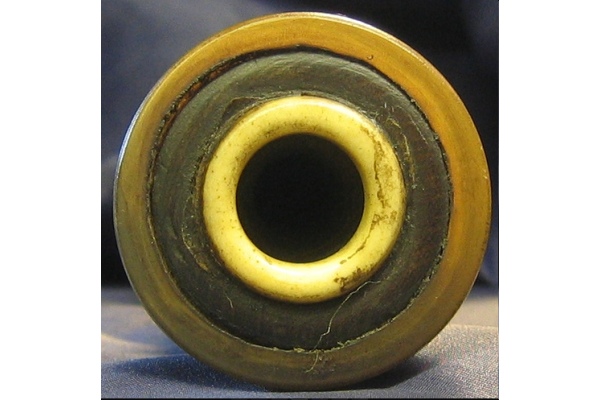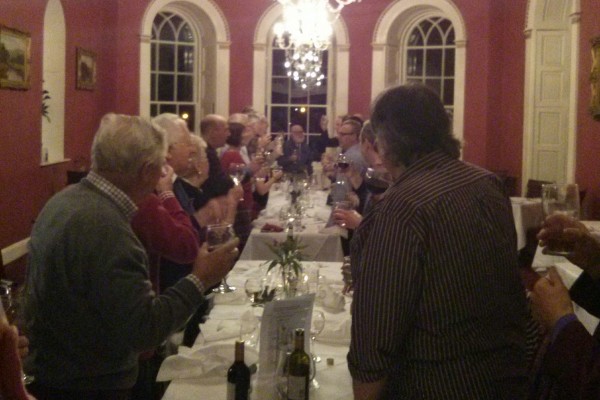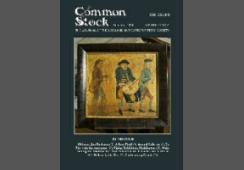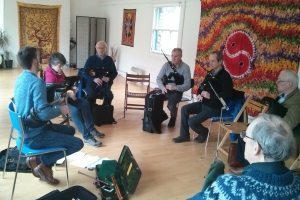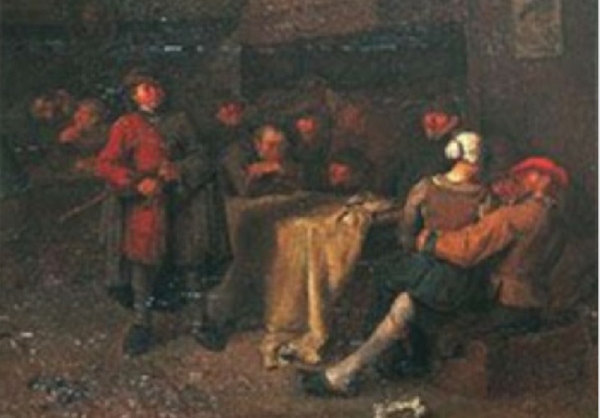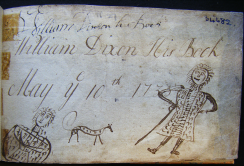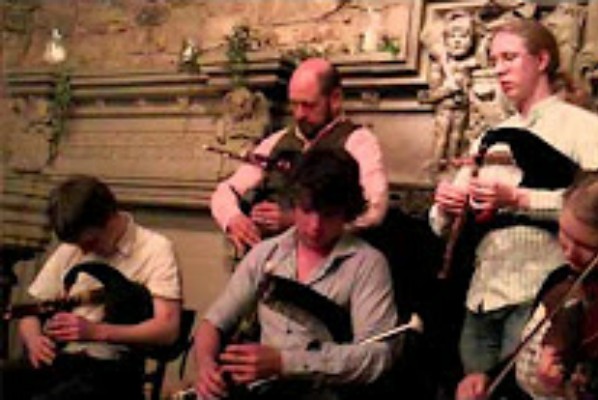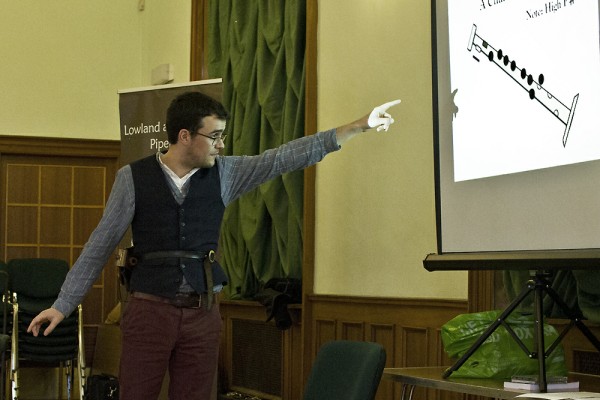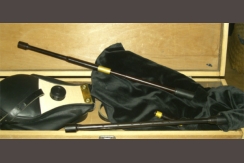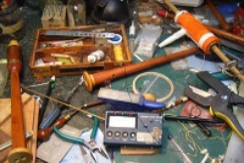On Saturday morning at the Peebles Collogue, Ewan McVicar, Anne Pitcher and Habbie himself gave us an insight into the the traditions of the town of Kilbarchan that celebrate their famous piper
Kilbarchan resident and storyteller Anne Pitcher first introduced us to the village of Kilbarchan, near Paisley in Renfrewshire, to the west of Glasgow. It has a long history, stretching back to the supposed arrival in Scotland of Barchan, an Irish monk who may have accompanied Colomba in the 6th century. He is said to have founded a church on the site where the West Church now stands. The village came to have a thriving handloom-weaving industry during the 18th century, and a weaver’s cottage dating from 1723 has been preserved as a museum. Kilbarchan’s most famous historical character however, is Habbie Simpson, whose story is told in the Elegy written by Robert Sempill.
Habbie’s statue stands in a niche near the top of the town Steeple. The Steeple was built in 1755 and the statue was originally carved in wood by Archibald Robertson of Greenock in 1822, but it later fell into disrepair and was replaced in 1932 by a bronze statue, the cost of which was raised by public subscription.

The Steeple, with Habbie’s statue
Anne then introduced Ewan McVicar, whose father was a ‘Habbie’, the name given to those born in the village. Ewan introduced the poem ‘The Life and Death of Habbie Simpson Piper of Kilbarchan’, at which point Habbie appeared, resplendent in the costume recently woven by hand in the Weaver’s Cottage. Ewan then talked us through the poem verse by verse, accompanied by appropriate music played by Habbie. Each verse was displayed on the screen along with the original sources of the music Habbie played.
When it came to the final verse, to accompany the slide of his gravestone, Habbie left us, piping the lament ‘Woe Betyde Thy Weary Bodie.’
Ewan then handed back to Anne who described the festivals that once were celebrated in the village. St Barchan’s Day, a mid-winter celebration, held traditionally on the 6th of December. This is no longer part of Kilbarchan’s calendar, though the day is recalled in the rhyme ‘St Barchan Bricht, shortest day, longest nicht’. Kilbarchan’s unique festival day ‘Lilias Day’, however, is still vibrantly celebrated. Held on the first Saturday in June, it is said to be named after the local laird Baron Cunninghame’s beautiful daughter Lilias who was born in the late 17th century. In those days Lilias Day seems to have taken the place of the Beltane or summer fair which Habbie Simpson is said in the poem to have played his pipes for. A Lilias Day is described in 1687 as having all sorts of farm produce, cattle and sheep, and there would be foot and horse races. Then there would be a procession of tradesmen and military with drums beating, music playing captains and lieutenants-garlands, swords brocaded. Time passed and at some point the parade of tradesmen changed to an historical parade which told Kilbarchan’s story. Beautiful floral arches were made by villagers for the parade to go under. Lilias Day stopped at the beginning of the first World-War.
A revival was experienced in the 1930s. It was a huge affair – with 30,000 people attending 1933 Lilias Day. The story of Kilbarchan was told in a seven-episode pageant on Lilias Day and several other days. Habbie Simpson’s story is told in Episode 5. This is from the 1933 programme:
“Children enter singing and dancing and are followed by the villagers. A pedlar moves about selling his wares. Habbie Simpson and his wife Janet are joyfully hailed by the villagers, who demand a tune on the pipes. They dance ‘The Glasgow Highlanders’. This dance belongs to Renfrewshire and is centuries old. The group is lead off by Habbie with his pipes”

Habbie and his wife Janet,
from the 1933 programme
Anne went on to describe a conversation she had with elderly Habbie, Betty MacDonald, who is 92 years young. She recalled Lilias Day of 1933. Her father was George Fulton, a blacksmith, her mum ran the ironmonger’s shop. “I was so excited about Lilias Day; it was wonderful and everyone wanted to be there. My dad George Fulton was the blacksmith across from the Steeple and he was on one of the floats with his anvil and tools. There was an arch at Steeple Street and everyone had to help to get it ready. They made a big wooden arch frame to put all the flowers and greenery on. It was fiercely competitive. Then the men and the boys would go up to the Burntshields woods and cut the heather and greenery, piling it onto lorries. The men walked back following the loaded lorries exhausted but happy. All the women would go out with their daughters and sisters to collect flowers and leaves in the big washing baskets, going from door to door. It was a happy time, lots of laughter and joking and fun. A parade convener was in charge of each arch and the rivalry was fierce amongst the streets. The arches had to be high enough to let a double-decker bus pass underneath which was quite a tall order. I remember everyone would be working on the arch up until midnight and beyond to get it ready for the next day.”
The revival in the 1930’s only lasted a few years, and it was not till 1968 that a Lilias Day as such was celebrated again. The Kilbarchan Parents Association revived the practice, and with some changes it continues today – it is the very heart of Kilbarchan.
Weeks before Lilias Day flags line the streets from Tandlehill to the public park. Instead of floral arches, people decorate their houses, business and community premises. On the day instead of the seven episode pageant telling Kilbarchan’s story there is a historical parade with locals dressed up in costume: it travels from the bottom of the village to the Public Park.

Lilias Day, Kkilbarchan, 1931
The parade stops at the Steeple, St Barchan knocks on the door of the Steeple and says “Habbie Simpson I command you to join the parade”. A St Andrew’s flag is draped over Habbie Simpson’ statue in the niche of the Steeple and then an amazing, magical thing happens: Habbie comes alive and steps out of the door of the Steeple.
At this point in the talk, Habbie appeared again, playing ‘The Day it Daws’. Anne then described how Habbie then goes to join his wife Janet and the villagers in the parade. When the parade reaches the Public Park Miss Lilias (this year Victoria Thompson), makes her proclamation. Then there is entertainment, competitions, prizes awarded and people enjoy buying from the many charity stalls.
At this point Ewan introduced us to a Lilias Day song written by the pupils of P 5/6 in Kilbarchan Primary School - with his help. The audience joined in with what was a very silly moment. Anne then described how, at the end of Lilias Day around 7pm, Habbie goes to Steeple Square, plays some dance tunes on his pipes, some folks enjoy a dance. A dram of whisky is offered, and then he goes into the door of the Steeple. (Here Habbie left us, playing the ribald song ‘Woe Betyde Thy Weary Bodie’)
Once he is inside, the St Andrews flag is drawn away and Habbie is revealed to be once more back in his niche turned to bronze, where he will stay till he magically comes alive again on the next Lilias Day, drawing both the past and the present together for future generations.
Lilias Day, around 7pm Habbie goes back to Steeple Square, plays some dance tunes on his pipes, some folks enjoy a dance. A dram of whisky is offered, then he goes into the door of the Steeple. At this point Habbie left us, playing the ribald song ‘Woe Betyde they Weary Bodie’
The St Andrews flag is then drawn away and Habbie is once more back in his niche turned to bronze till he magically comes alive again on the next Lilias Day, drawing both the past and the present together for future generations.

Broadsheet version of the Elegy, c.1700
The music Habbie played is on the next few pages. The pipes he played it on were made by Julian Goodacre, pipemaker of Peebles; a chromatic high D chanter with single bass drone three octaves below, an instrument not far removed from that shown in the Threave Castle panels, dated c. 1600 (See Common Stock, June, 2015)
Kilbarchan now may say alas!
For she hath lost her game and grace
Both TRIXIE and the Maiden Trace
But what remead?
For no man can supply his place
Hab Simson’s dead‘

Hey go Trixie, Trim go Trixie
Under the Greenwood Tree’
The words first appear in a scurrilous anti-papist ballad around 1560, and in a number of later songs. Habbie played the setting in John Walsh’s Dancing Master, 1697.

Now who shall play The Day it Daws
Or Hunt’s Up when the cock he craws
Or who can, for our kirktown cause,
Stand us in stead?
On bagpipes now nobody blaws
Sin’ Habbie’s dead
‘Tharto thyr byrdis singis in the schawis/ As menstralis playing ‘The joly day now dawis’
Gavin Douglas, Aeneid, c. 1512
The music is from the Fairfax MS, c. 1500, a song for four voices. Shown here is the first voice on the first page of the MS; a transcription was printed in the June 2015 edition of Common Stock.

The Scotch Hunts Up
‘The cadger sang ‘huntis up, up, upon hie’
Robert Henryson, c. 1480
At least two different tunes with this title survive from the late 16th century. One was printed in the June 2015 issue of Common Stock. Habbie played the other one, from the Matthew Holmes Lute MS, c. 1595.
Or wha will cause our shearers shear?
Wha will bend up the brags o’ weir?
Bring in the Bells, or good play-meir
In time of need?
Hab Simpson could, what needs you speir
But now he’s dead.’
‘To ane pyper to play to the scheris in harvest £4’
(from the accounts of Douglas of Lochleven [in Fife], 1574
Habbie played the setting of ‘Rob Shear in Harvest’ from Walsh’s Complete Country Dances, c . 1740.
Walsh’s setting is included here since it is either a unique take on the material or a complete misunderstanding; an edited pipe version of this setting, more closely following other later settings, is shown below:

So kindly to his neighbours neist
At Beltan and Saint Barchan’s Feast
He blew, and then held up his breast
As he were weid,
But now we need not him arrest
For Habbie’s dead.Here
Habbie played the dance tune ‘Canaries’, but not for so long as to make him ‘weid’. The music for this and the following three tunes is from Dauney’s ‘Ancient Scottish Music’, transcriptions of the Skene of Halldays mandore MS of c.1630, available on line at the archive.org website.

At fairs he played before the spearmen
All gaily graithed in their gear men
Steel bonnets, jacks and swords so clear then
Like any bead
Now wha will play before such weir-men
Sin’ Habbie’s dead?


Here Habbie played ‘Put on Your Sark on Monday, again from Dauney;s transcription.
The image is from the Threave panels, c.1600, that appear to show a fair and ‘wappenschaw’. ‘The true meaning’, says Dauney, of the title of the tune, ‘is that they are to buckle on their armour or coat of mail on Monday’.
The final 8 bars of Dauney’s setting have required serious editing to restrict the range within nine nites. They nevertheless retain the essential format, showing the kind of variation writing present in the Skene manuscript
At Clerk plays when he wont to come
His pipe played trimly to the drum
Like bykes of bees he gard it bum
And tuned his reed
Now all our pipers may sing dumb
Sin’ Habbie’s dead

The music, again from Dauney, is the leather workers march, Three Sheepskins, said to have been played on the bells of St Giles in Edinburgh on the day of their procession.

Wo Betyd Thy Wearie Bodie (from the Straloch Lute book, c.1625) This was probably the tune for a ribald song, though Habbie also played it as a lament, with F naturals.
